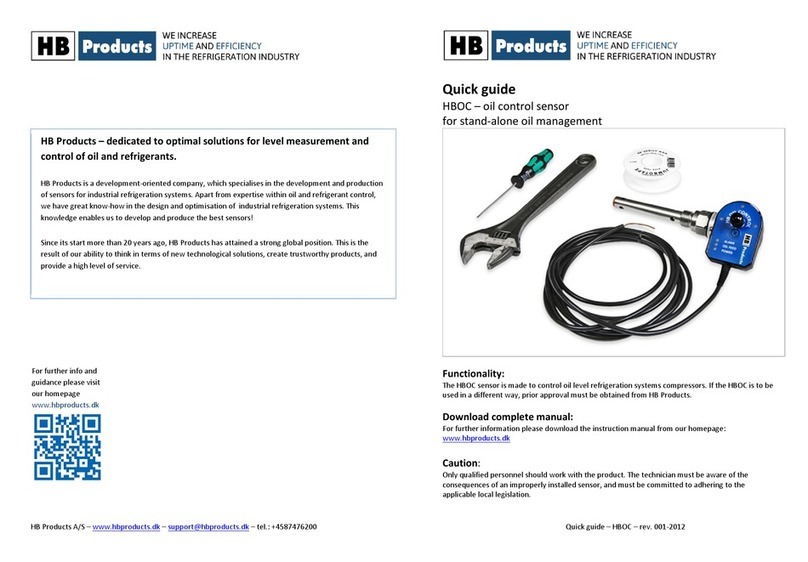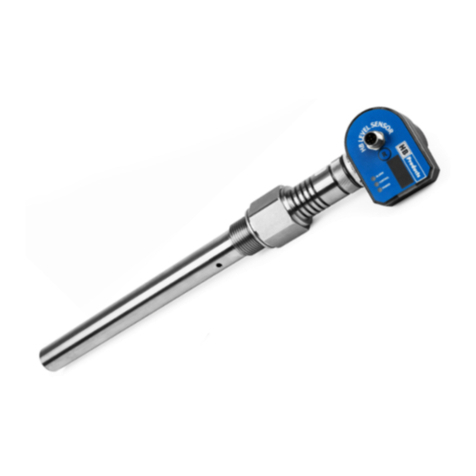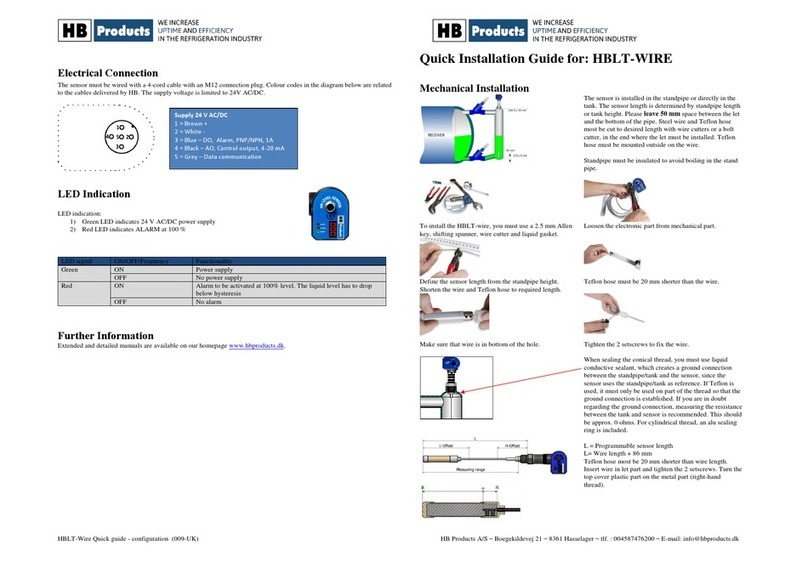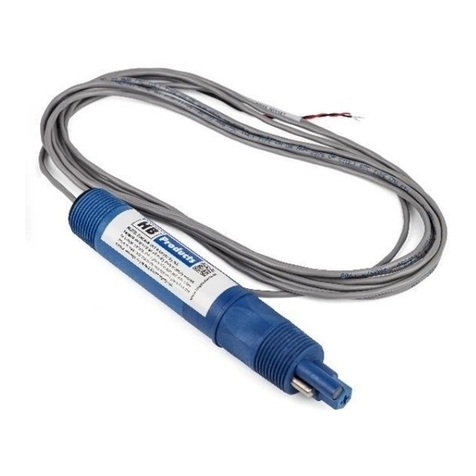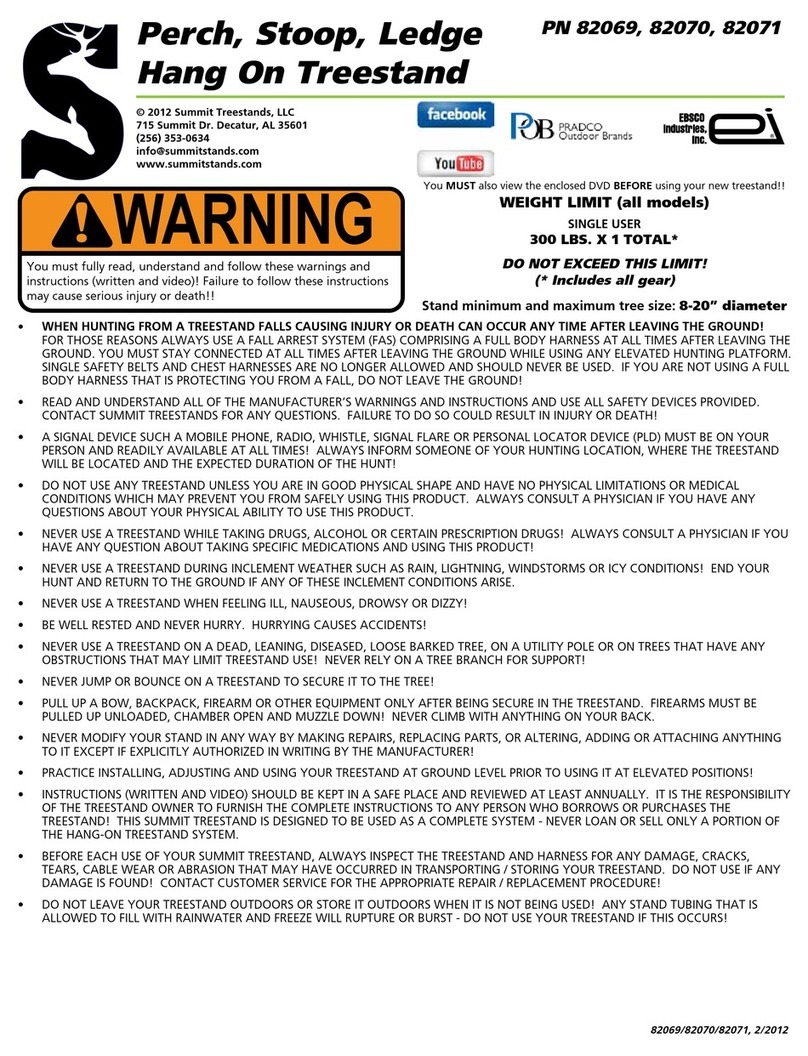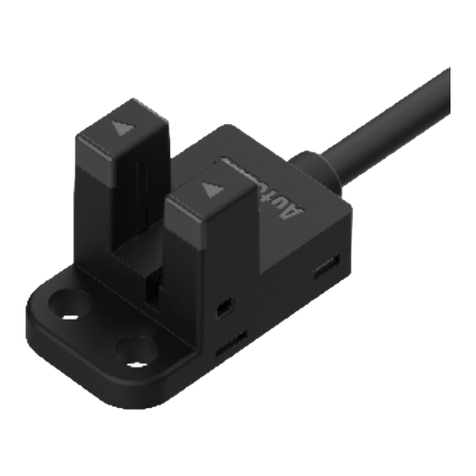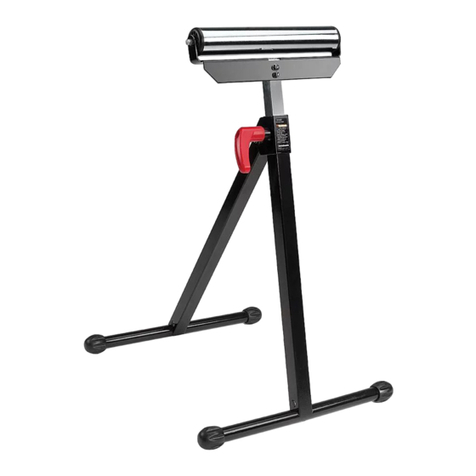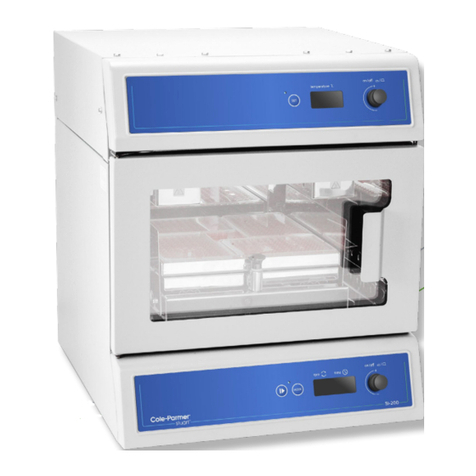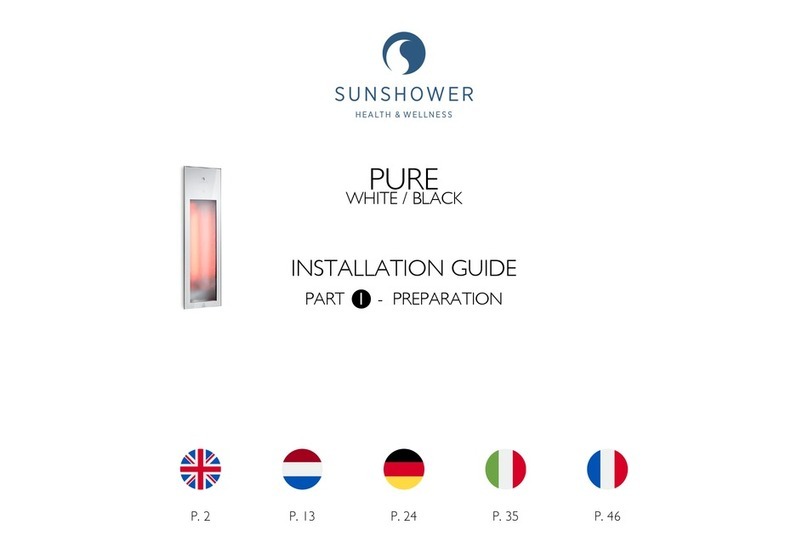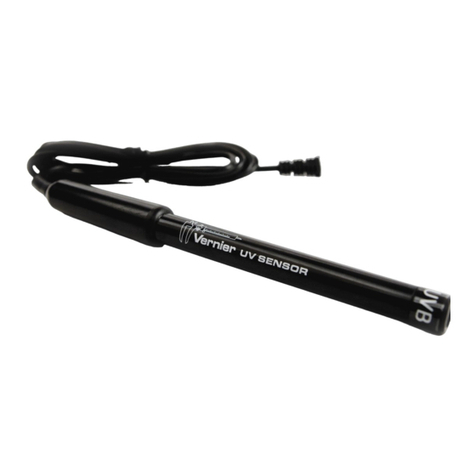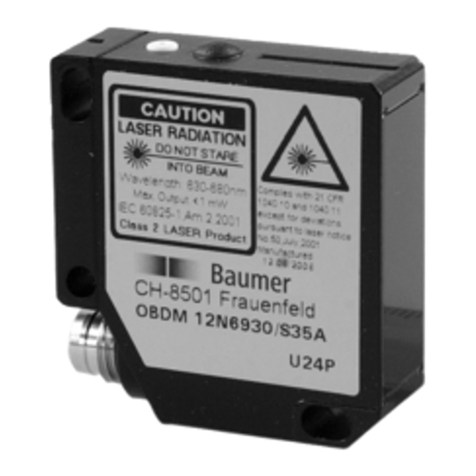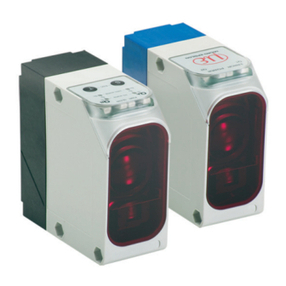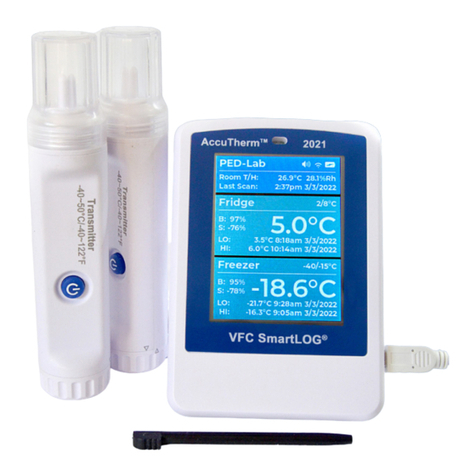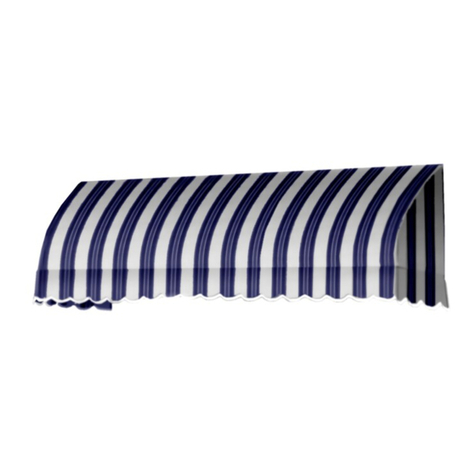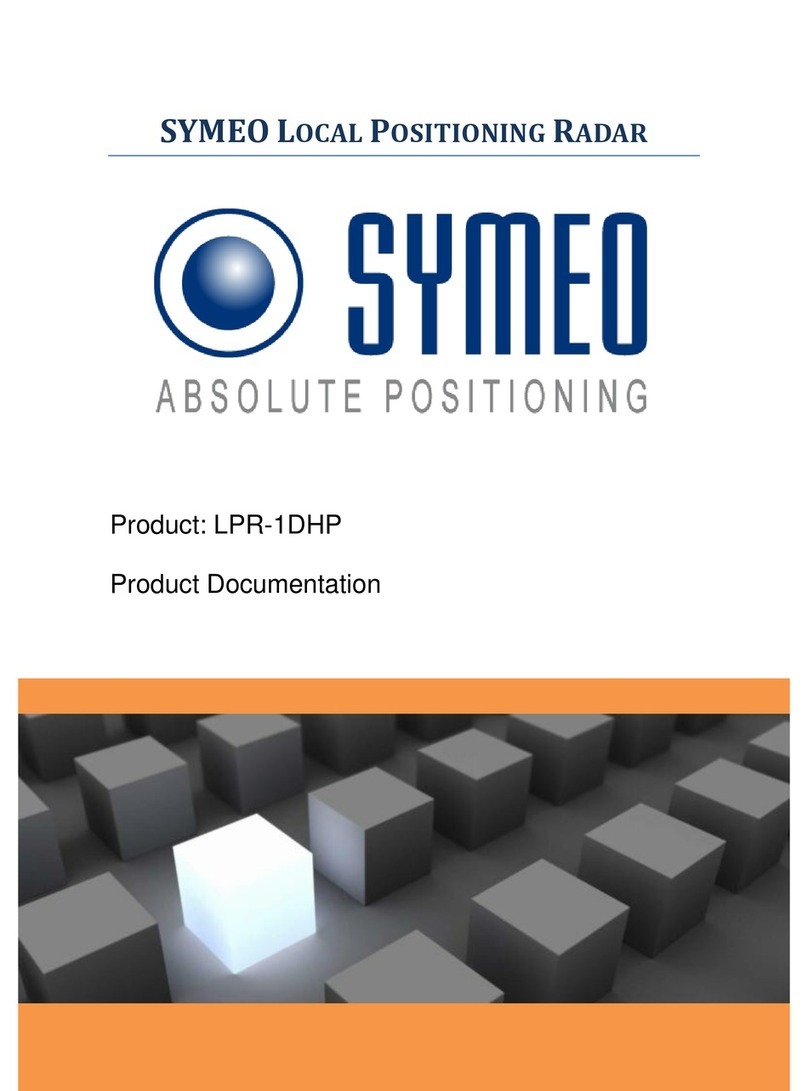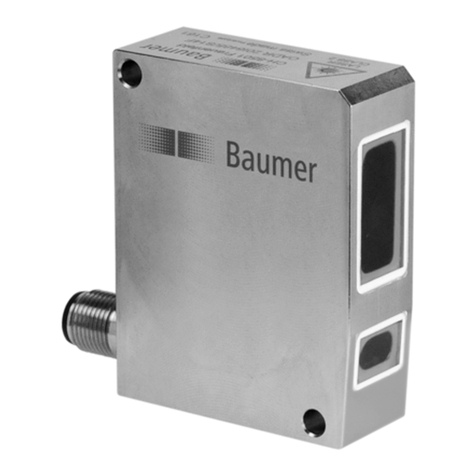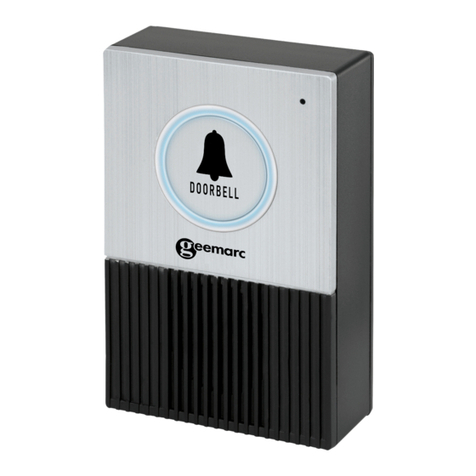HB Products HBX Operator's manual

HBX-all types installaon and calibraon manual 03 date: 26-06-2020 WWW.HBPRODUCTS.DK
Installation and conguration guide
HBX Vapor Quality sensor
Sensors for optimizing Evaporator Control, both for DX (direct expansion) and
overfeed - systems
For compressor protection and leakage detection (ammonia carbamate)
Introduction:
The three dierent versions are available, with the same function. Pipe size and piping layout, bend or
straight, is dierent and suited for dierent applications. The strainer house version has one xed ow di-
rection, whereas the two stainless versions accept ow in both directions.
HBX Vapor Quality Sensors measures the Vapor Quality of the refrigerant vapor leaving an evaporator and
use this signal for controlling the expansion valve. Thanks to the capacitive measurement principle it is able
to measure the liquid content of the uid leaving the evaporator without pressure drop.
For “DX” systems the vapor quality sensor can replace the conventional superheat control and is able to re-
duce the superheat to zero. The sensor can control the valve directly or it can provide the high vapor quality
measurement for an external control system. The vapor quality sensor reacts instantaneously if the dryness
of the gas is changed in the evaporator outlet. Experience has shown that the entire system is in better bal-
ance with minimum variation in pressure.
In overfeed and ooded systems the sensor is able to measure the low vapor quality in the evaporator outlet
and control the circulation ratio (CR) by controlling the liquid valve or the pump capacity, either directly or
as an input for a PLC.
The sensor is manufactured in stainless steel or carbon steel and can be used for all commonly used refrig-
erants CO2, Hydrocarbons, ammonia, HFO’s and HFC’s with dierent settings. The HBX sensor is available in
several versions, with and without temperature sensor and cable for direct connection to an expansion valve.
Three types of expansion valves are supported: stepper motor, PWM pulse modulating ex. AKV valves and
modulating 4-20mA controlled expansion valve.
A special ATEX/IECEx (EEx ib IIC) version is available for use in special hazardous areas and with ammable
refrigerants. This product is only suited for external control and is not able to control an expansion valve di-
rectly.
Angle rod version
In-line version
Angle strainer versions

2
HBX-all types installaon and calibraon manual 03 date: 26-06-2020 WWW.HBPRODUCTS.DK
Table of Contents
Introducon............................................................................................... 1
Safety Instrucon ...................................................................................... 2
Applicaon and mounng strainer house version .................................... 3
Applicaon and mounng straight pipe version ....................................... 4
Applicaon and mounng angle rod version ............................................ 5
Installaon of temperature sensor............................................................ 6
Removal of electrical unit.......................................................................... 7
Sensor conguraon ................................................................................. 7
How to use the sensor............................................................................... 8
How to setup the sensor as input for a PLC .............................................. 9
Advanced sengs for sensor as input for PLC input............................... 10
Using the sensor for ooded operaon together with a PLC ................. 11
Operang a batch freezing process......................................................... 11
Using the alarm funcon for leakage control and comp. protecon ...... 11
Calibraon of sensor ............................................................................... 12
How does the expansion valve control loop work for DX operaon…..…14
How to setup the sensor as direct controller—basic sengs................. 16
How to setup the sensor as direct controller—Advanced sengs ......... 17
Controlling a ooded or semi ooded evaporator ................................. 18
Connecng diagram stepper motor ........................................................ 19
Connecng diagram motor valve ............................................................ 20
Connecng diagram pulse modulang.................................................... 21
Connecng diagram PLC and ATEX/Ex/IECEx ......................................... 22
Remote seng ........................................................................................ 23
LED indicaons on sensor head............................................................... 24
Use of the sensor with other refrigerants ............................................... 24
Safety Instructions
CAUTION! Read this setup guide before installing and using the HBX Sensor.
Installation of HBX sensor must be carried out by a trained professional with in-depth knowledge of both refrigera-
tion and electronics. Improper installation and use of the HBX Sensor may result in damage to material and/or peo-
ple. The installation and use of the HBX Sensor must be done according to local regulation.
Altering type-approved equipment voids the type approval. The product's input and output, as well as its accesso-
ries, may only be connected as described in this guide. HB Products assumes no liability for damages resulting from
failing to follow the instructions in this setup guide.
Intended use. The purpose of the HBX sensor is refrigerant measurement and control.
If the HBX is to be used in a different way, prior, written consent must be obtained from HB Products.
Repair: Any repair must be carried out by a trained professional.
Disposal instructions: The HBX is designed for long life operation. If or when it becomes necessary to dispose of
the sensor it must be done according to local regulation.
CAUTION! This symbol refers to a possible limitation of functionality or risk in usage.
NOTE! Contains important additional information about the product and provides further advice.
CAUTION! Factory sengs do not guarantee safe operaon since the conguraon
parameters depend on the system design

3
HBX-all types installaon and calibraon manual 03 date: 26-06-2020 WWW.HBPRODUCTS.DK
Up
Flow direcon
Flow direcon
H
H
H
Risk of trapped refrigerant
around the sensor disturbs the
measurement when lid points
downwards
Application and mounting instruction
Sensor mounted in a strainer house (HBX-xxx-ST)
The HBX-sensor is mounted after the evaporator and is able to measure the Vapor Quality (dryness) from 0.2 to 1. The
output can be used as input to a PLC or it can control the expansion valve directly or both. The sensor is mounted in a
strainer house where the strainer is replaced by the sensor. Compared to the original strainer the ow direction is
opposite and the mounting is upside down.
The sensor have to be mounted in downward sloping pipes to ensure drainage of refrigerant, and oil. The lid needs to
be upwards as other mountings will be sensitive to oil contamination and trapped refrigerant during startup.
When the sensor is welded into the plant the lid and sensor have to be removed. After the welding the piping have
to be checked for welding debris and deformations which might disturb the measurement. The distance between
the sensor element and the wall has to be uniform.
The lid with sensor is reassembled and the bolts are tightened according to the table.
HRemove lid with sensor
before welding
Max torque for bolts
H
Flow direcon

4
HBX-all types installaon and calibraon manual 03 date: 26-06-2020 WWW.HBPRODUCTS.DK
Application and mounting instruction
Sensor mounted in a straight pipe HBX in-line
The HBX-sensor is mounted after the evaporator and is able to measure the Vapor Quality (dryness) from 0.2 to 1. The
output can be used as input to a PLC or it can control the expansion valve directly or both. This sensor version is
mounted in a straight pipe and it accepts ow in both directions.
The sensor can be mounted in dierent positions as long as you make sure there is no trapped refrigerant inside the
sensor during startup. Mounting the sensor with the electronic unit pointing downwards is not ideal as the connectors
might disturb the liquid ow in the bottom of the pipe and make the measurement unprecise.
The electrical unit can be mounted on either of the two connecting points
When the sensor is welded into the plant the electronic unit
has to be removed in order to protect it from the heat. The
studs have to be cooled during welding as they include O-rings
which does not tolerate temperature beyond 100°C (212°F). A
wet cloth is normally sucient to cool the studs.
Remove electronic unit be-
fore welding or soldering and
cool the studs ex. with a wet
cloth.
With the sensor downwards the
internal connections will disturb
the liquid ow in the bottom of
the pipe. The measurements
might be unprecise
Apply
cooling
When mounted horizontally
make sure refrigerant and
oil is drained for instance by
inclining the sensor 1
This mounting
will suer from
trapped refrig-
erant in the
sensor tube

5
HBX-all types installaon and calibraon manual 03 date: 26-06-2020 WWW.HBPRODUCTS.DK
HBX
Flow direcon
Angle minimum 30 downwards
Evaporator
Application and mounting instruction
Angle rod version
The sensor accepts ow in both directions, but has to be mounted in downward sloping pipes to ensure drainage of
refrigerant, and oil. The sensor can be mounted in dierent positions. But some will be sensitive to oil contamination
and trapped refrigerant during startup. Make sure that the sensor rod inside the long pipe is free from trapped refrig-
erant and oil at any time. The sensor pipes have a larger dimension than stated in the specication, but is delivered
with reductions to t the specied pipe diameter. This is done to avoid pressure loss coming from a massive inner rod
lling some of the pipe and reducing the cross section
Workarounds for low mounted evaporator outlets
It is important to secure drainage of liquid refrigerant and oil as this could
aect the sensor and especially oil is dicult to remove with a low velocity
gas. Especially in small systems without oil separator, it is important to keep
the sensor free from oil to avoid it disturbing the measurement.
Both pipes should be angled minimum downwards 1 degree or designed with a
P-trap/drop-leg to secure drainage.
This mounting will suer
from trapped refrigerant in
the metal block, where the
sensor is mounted
This mounting will suer from
trapped refrigerant in the
sensor tube
This mounting will suer from
trapped refrigerant in the sensor
tube
H
Flow direcon
Flow direcon
Slope downwards

6
HBX-all types installaon and calibraon manual 03 date: 26-06-2020 WWW.HBPRODUCTS.DK
Installing the Sensor
The sensor is installed in the outlet of the evaporator, as part of the sucon line. Soldering connecon, ngs and pipes are
made of stainless steel. The sensor part itself must be removed by unscrewing it from the steel block/base part before sol-
dering.
Unscrew the complete sensor part before solder-
ing.
Use two wrenches when dismantling and installing
the HBX-Sensor. One to turn the sensor and one on
to stabilize the steel block to avoid stress to the
soldering's.
Use thread sealant.
We recommend using liquid thread sealant when
installing the sensor
Insulate the entire
mechanical sensor
part with insulation
foam.
Temperature sensor installaon
Refrigeraon systems working with NH3 can operate well without a temperature sensor, but most other refrigerant benet
from temperature measurement. The temperature measurement is used for oseng the Zero point and makes the meas-
urement more accurate.
The sensor normally has a cable with a temperature sensor which has to be mounted to the pipework using cable es or to
the lid of the larger strainer models. The mounng on the outside of the pipe provides sucient accuracy. The temperature
sensor compensates for the change in the dielectrical constant with the temperature and make the measurement more ac-
curate when starng the system.
The temperature sensor should
be mounted to a pipe in posi-
tion 3 or 9 o’clock with cable
ties as shown.
For strainer houses the clip can
be used for attaching it to the
lid

7
HBX-all types installaon and calibraon manual 03 date: 26-06-2020 WWW.HBPRODUCTS.DK
Sensor conguraon
All HBX sensors can be calibrated using a PC and a, M12 -USB cable. The soware can be downloaded freely on the HB
Products web page. The conguraon data can be stored in the sensor and will be there unl erased without power con-
necon—just like you store data on a memory sck. When you change a value /seng there will be put a check mark next
to it and that indicates you have changed something and need to store the data in the sensor.
When the sensor is mounted in a refrigeraon plant where it is dicult to reach or it is very cold you should consider us-
ing an M12 extension cable in your installaon. This allows for conguraon of your sensor where you have your M12/
M12 connecon.
PLC
Cable from HB sensor
USB
M12 female
M12 male
USB conguraon cable used for con-
necng all sensors with M12 con-
nector to a PC with the HB tool
order code HBxC-USB
Removal of the electrical unit
End view without electronic unit
The threaded union between the electronic and
mechanical part allows for fast removal and
remounng of the electronic element without
interfering with the pressurised system. No
tools are needed for the operaon.

8
HBX-all types installaon and calibraon manual 03 date: 26-06-2020 WWW.HBPRODUCTS.DK
Setup — sensor or control
The sensor can operate in two very dierent modes
• As sensor input to a PLC, computer or other device that
uses the sensor signal
• A direct controller of an electrically controlled expansion
or liquid valve version with a cable output that can be set
up as a controller
Select Control/Sensor to select the mode
How to use the sensor
Two dierent versions
Two dierent versions exist
• A pure sensor version—without the controller capability
• A version which can both control an expansion valve with a simple input and act as a sensor together
with a PLC
The sensors that are able to control an expansion valve have a cable beside the temperature sensor cable,
which can be connected directly to the valve. The sensors which are specied only to provide a signal for a PLC
will only have the M12 connection. All sensors, except those for NH3 refrigeration, has a cable with a PT1000
temperature sensor, which measures the operating temperature and makes the needed compensations.
Alarm application
Some of the sensors can be used for providing an alarm when the liquid level is high or if ammonia carbamate
is detected. The sensor can still be used for measuring vapor quality and control a liquid valve either directly or
via a PLC
Stop-
start
Power
24VDC
PLC
Sensor only version
Controller and sensor
version
PLC
See page 9 and
forward
See page 14 and
forward

9
HBX-all types installaon and calibraon manual 03 date: 26-06-2020 WWW.HBPRODUCTS.DK
Typical values for DX operation
When the sensor is not operating as a controller some of the parameters are irrelevant and the boxes are inactive
and shown in grey.
1. Set lter time to 2 seconds. The lter time is the period of time over which the X measurement is averaged.
The longer the range the smoother the measurement becomes, but the risk is that the system becomes too
slow.
2. Run in signal (digital input pin 5) is used as external start and stop when operating as a controller and
should be set to OFF
3. Zero cal. function: Choose ”ON” if you want to use the push bottom ”R” for zero calibration
4. The “Alarm setting in “X” “ and “Alarm delay in seconds” can be used, but normally the alarm is pro-
grammed in the PLC directly based on the mA signal.
5. The temperature compensation function is set to “Temp oset” unless you don’t want this functionality. This
only applies if the sensor has
a temperature sensor
6. “Select refrigerant type” is
for information only and
should not be used for chang-
ing refrigerant as it does not
change the important set-
tings, and the sensor will not
provide the correct measure-
ments. If your refrigerant is
not correct you need a com-
plete settings le - please con-
tact HB-products for this.
7. After changing settings push
the button ”Save to sen-
sor” (the message ”OK” on the
screen indicates that the set-
tings are saved)
8. Go to next page: Advanced
settings
How to setup the sensor as input for PLC
When using the sensor as input to a PLC the analog output
is used. The output can be scaled by adjusting a parame-
ter. Dry gas will always be 4 mA but the “X measuring
scale” found in the Calibration tab denes the 20 mA point
The ”X measuring scale” can be changed in the calibraon tab

10
HBX-all types installaon and calibraon manual 03 date: 26-06-2020 WWW.HBPRODUCTS.DK
When the sensor is used as input for a PLC only the
relay function can be modien in the advance set-
tings' tab
1. Alarm output, NO (normally open) or NC
(normally closed) , default is ”NC” (Fail safe
function)
2. After Changing settings push the button ”Save
to sensor” (a message ”OK” on the screen
indicates that the settings are saved)
3. Save settings le is used to save all the set-
tings as a txt le
4. Load settings le is used to set up all parame-
ters from an existing txt le (copy data to a
new sensor)
Advanced settings for sensor as input for PLC
Tick o here for geng
access to selecon of
applicaon
Tick o
Set minimum
value here
Tick o here
and select
sensor type
Click here to
store the data
in the sensor
Under the calibration tab, the sensor can to be set to ooded operation called “HBX-CR” or DX but it does not really
matter when used for PLC input only.
How to change the “X measuring scale”
You start by ticking o the three small boxes to the right. At the same time you can change the operation range
from minimum in the box called “X measuring scale” to maximum called “Dry sensor” When you are done changing
the parameters, you store them in the sensor by clicking on “X scale calculation”

11
HBX-all types installaon and calibraon manual 03 date: 26-06-2020 WWW.HBPRODUCTS.DK
Using the sensor for ooded operaon together with a PLC
The output of the sensor can be used for controlling a liquid valve directly or the analog output in pin 4 can be used as
input to the PLC. The signal is scaled linearly from 4 to 20 mA where 4 mA is sent for the “dry sensor” and the 20 mA
for the minimum “X measuring scale”.
An Example:
If you set the minimum to 0.50 and maximum to 1.00 you will get 16 mA for “degree of dryness “X” of 0.625
AO signal: 20— 16* ( 0.625-0,5) / (1,0-0,5) =16 mA on pin 4
Operang a batch freezing process
Batch freezing is dicult to control due to a large capacity variaon throughout the cycle. A way to control the process
it to start the freezing cycle as ooded and end it as DX. It
requires a PLC to control the expansion/liquid valve and make
a graduate change of the circulaon rao from 3 to 1, which
is equal to changing the X value from 0,3 to 1 as this formula
can be used: X=1/CR
The advantage of this way of controlling is increase the cool-
ing capacity in the last part of the cycle and avoid slug ow in
risers due to overfeeding. The DX operaon at the end re-
duce the pressure drop and lowers the energy consumpon.
The graph show how the X and CR value can be adjusted
during the cycle.
Using the alarm funcon for leakage control and compressor protecon
Some sensors can provide a digital output signal on pin 3 when the alarm level is reached.
This can be used for leakage control in a CO2/NH3 system where ammonia carbamate
will be created or for compressor protecon.
For leakage control the “Alarm seng in X” have to be set 20% below the normal oper-
ang point so for DX operaon it could be 0.8.
For compressor protecon the “Alarm seng in X” have to be set at around 0.97 to 0.98
depending on the system.
The “alarm delay in sec.” have to reect the system and have to be as low as possible.
The “alarm relay funcon” can be adjusted to either deliver a digital output or remove
the signal when the limit is passed
Current for
minimum “X”
Range
(20-4 )mA
minimum
maximum
X
minimum
Basic sengs
Advanced sengs
Cycle me in %

12
HBX-all types installaon and calibraon manual 03 date: 26-06-2020 WWW.HBPRODUCTS.DK
Calibraon of sensor for DX operaon
The sensor is delivered with a basic calibraon for the refrigerant you specied when ordering. The sensor can be used
directly without further calibraon. You can check the calibraon as described below. If the calibraon is not opmal the
accuracy can be improved by making a simple dry calibraon at normal operang temperature, when the system has
been operang for some hours. The calibraon procedure is described in the secon below. The calibraon will depend
on
• Refrigerant
• Sensor and pipe dimensions
• Operang temperature (the temperature sensor will eliminate the inuence of the temperature)
How to check your calibraon and make a new calibraon of sensor controlling an expansion valve
Start your refrigeraon system and let it reach normal operang temperature.
Make sure the sensor is completely dry which can be done in dierent ways depending on your system
• If possible close the expansion valve manually and wait 1 minute for the system to evaporate all the
refrigerant
• Set the “degree of dryness “X” to 1.00 and the “Minimum valve opening in %“ to 0 this is done with the HB
tool as described before. Wait for 2 minutes
a. Disconnect the M12 plug and connect a PC with the HB tool with an USB/M12 cable.
b. Check that the control bar at the boom of the page indicates 0%
c. Select the “calibraon” tab and you get the picture shown.
d. Your calibraon is perfect if you don’t get a lower “Actual measurement in pF” than the value stated in the eld
“Dry calibraon in pF”. If the “Actual measurement in pF” is lower you need to make a new calibraon. This is done
by clicking on the “Dry sensor calibraon” boom. If the “Dry calibraon in pF” sll is higher than the “Actual
measurement in pF” click the buon once again.
e. When the calibraon is perfect, set the
“degree of dryness “X” back to normal, and
the “Minimum valve opening in %“ to normal
and then unplug the PC, reconnect the nor
mal M12 plug .

13
HBX-all types installaon and calibraon manual 03 date: 26-06-2020 WWW.HBPRODUCTS.DK
How to check your calibraon and make a new calibraon while sensor is connected
to PLC
Start your refrigeraon system and let it reach normal operang temperature.
Make sure the sensor is completely dry by closing the expansion valve manually and wait for the system to evapo-
rate all the refrigerant
3. Read the minimum “Actual measurement in pF” either from the PLC or by connecng a PC directly to the sensor
4. Your calibraon is perfect if you don’t get a lower “Actual measurement in pF” than the value stated in the eld
“Dry calibraon in pF” if the “Actual measurement in pF” is lower you need to make a calibraon. This is done by
clicking on the “Dry sensor calibraon” buon. If the “Dry calibraon in pF” sll is not lower than the “Actual
measurement in pF” click the buon once again.
Calibraon using a splier box
When using a splier box it is possible to run the refrigeraon system and connect a PC to the sensor at the same me.
The splier box is not suited for normal operaon, but only for installaon and modicaon. The splier box is connect-
ed to the M12 plug on the HBX sensor and then both the pc and the normal M12 plug can be connected.
Calibraon of sensor operang in ooded systems
Dry calibraon of the sensor is not crical when used in a ooded system and it is not needed to calibrate the sensor. If
you like to do a calibraon is similar to DX operaon. Note before making a dry calibraon the maximum “Dry sensor” X
value have to be set to 1.00. If the maximum is set to a value lower than that please contact HB product support depart-
ment as calibraon is not straight forward and requires a special uid or the correct gas/liquid mixture.

14
HBX-all types installaon and calibraon manual 03 date: 26-06-2020 WWW.HBPRODUCTS.DK
How does the expansion valve control loop work for DX operation
From stop to start
To start the process you need to activate the run in signal by applying 5-24 V on pin 5 when you remove the voltage
the system will stop. If this signal is not set the automatic dry-out is not enabled. The run in signal should be applied
when the compressor starts to benet from the start up process with a dry out period.
Dry out period and kickstart period
The controller will open the expansion valve to dry out the sensor and start the process. This function is only active if
the sensor basic setting “run in signal” is set to “ON” The idea behind the dry out and kickstart function is to ensure a
rapid start up to avoid compressor cut out due to low pressure and avoid very low evaporator temperatures. The pro-
cess can be started by a fast opening of the expansion valve to generate a high gas ow from the evaporator through
the sensor and removing potential liquid refrigerant and oil. The opening of the expansion valve also prevents the sys-
tem from shutting down due to low suction pressure.
When a plate heat exchanger is used we recommend to kick-
start process to avoid freezing. Without kickstarting the very
low suction pressure might result in local freezing on the
secondary side and damage the heat exchanger.
The dry out run for a period specied in the parameter:
“Dry out function in sec” and is ramped up with the speed
set in the parameter: “Ramp dry out % in sec”. When the
dry out is done, ramp up to normal operation will begin.
If the system usually is dry after a stop or defrost, the peri-
od can also be used as a kickstart period. This is typically
needed in small system and especially in heat pumps where
the compressor has a tendency to drop out due to low suc-
tion pressure. Here you can try to increase the opening until
it works. Note you might hit the low level alarm limit.
Ramping up capacity
The system will start slowly due to a PI controller which will ramp up the capacity depending on the settings. The “P-
band in %” specify the target for the expansion valve opening and the “I-factor in sec” specify how long time it takes
to reach the target.
80%
Valve Opening
100%
60%
40%
20%
+5°K
LL Alarm...0.900
Set.point.0.980
Start with
Wet sensor
Dry sensor
Wet sensor
Vapor Quality
”X”
Voltage/signal on pin 5, Start/Stop Signal
applied when the compressor starts/stops
0%
Time
24V
0
Ramping up capacityDry out
and
kick-
start
period
stop Normal operaon stop
Valve opening
Sucon temperature
with kick start
Sucon temperature
with slow start up
Time
Temperature

15
HBX-all types installaon and calibraon manual 03 date: 26-06-2020 WWW.HBPRODUCTS.DK
What then happens is that the controller starts opening the expansion valve at “valve speed 2 open % in sec”
which means more and more liquid is sent to the evaporator. After a period the maximum capacity is reached and
the HBX sensor begins to detect liquid and the opening of the expansion valve is reduced to “valve speed 1 open %
in sec”. At this point the X value passes 1, where X value is a measure for the vapor quality where X=0 is all liquid
and X=1 is dry gas.
With the reduced valve opening speed the capacity will still increase until the setpoint “Degree of dryness “X” ” is
reached. After this point the controller will open and close the valve to maintain a stable “X “value.
Normal operation and stopping
The normal operation will continue until the system is stopped by removing the voltage on pin 5 for defrost or a
regular stop. After stop, the process will restart with a new dry out period, which is important for a smooth opera-
tion.
What happens when the process is disturbed
If something happens with the complete system which results in liquid in the evaporator outlet there is a build in
safety system that protects the compressor. If the sensor measures a “X” value lower than the “low limit safety
alarm in “X”” the valve will be closed rapidly until setpoint “Degree of dryness “X” ” is reached again. The speed
can be adjusted in the parameter: “Low Limit Valve close %/sec” and is as default set very high for safety rea-
sons—it might lead to unstable operation. If the system has an accumulator before the compressor the “Low Limit
Valve close%/sec” can be set to a lower value e.g. 0.8 instead of the default 0.9 to avoid instability. The gure be-
low shows what happens when the low limit safety alarm is hit.
To make sure the compressor is not shut down due to too low suction pressure there is a parameter: “Minimum
valve opening in %” in the system. There is also a parameter: “Maximum valve opening in %” which is there to
limit the liquid injection if the valve is too large.
How does the control loop work for ooded operation
The sensor can control a liquid valve or a circulation pump directly in a similar matter as for an expansion valve in
DX operation. The control loop can work with any vapor quality all the way to X=0 (all liquids) if needed.
HB-products support can help you with setting up the system.
Min. Valve opening
80%
Valve Opening
100%
60%
40%
20%
Valve opening/closing me
”X”
+5°K
LL Alarm...0.900
Set.point.0.980
Start with
Wet sensor
Dry sensor
Wet sensor
Vapor Quality
”X”
DI, Start/Stop Signal, Run-In…..pin 5
0%
Time
Valve Speed 2 Valve Speed 1
ON
OFF
Valve Close
Low Limit Safety Alarm at ”X” 0.9
Closing the liquid Valve to minimum Valve
opening (Ramp me controlled)
Valve Open
Speed 2
Valve Closing
Speed
Open
Speed 1
Dry out and kick-
start period

16
HBX-all types installaon and calibraon manual 03 date: 26-06-2020 WWW.HBPRODUCTS.DK
1. Set the desired degree of dryness, ”X” value. For DX operation a good starting point would be 0.98 the clos-
er to 1 you go the dryer the gas will be. The X value is the Vol% of liquid
2. Set the P-band to 10% as a starting point. If the value is set higher the valve will react slower
3. Set the I-factor to 40 sec as a starting point. This means the system will ramp up over a period of 40 sec-
onds. If the I value is set higher the system will be very slow
4. Set lter time to 5 seconds. The lter time is the period of time over which the X measurement is averaged
over. Increased lter time smoothens the measurement, but the risk is that the system becomes too slow.
5. Run in signal (digital input pin 5) is used as external start and stop signal when set to ”ON”. This is im-
portant. If set to “OFF” the dry-out will not work and there is a risk that the control system will not really
start up because the sensor is wet to begin with.
6. Zero cal. function: Choose ”ON” if you want to use the push button ”R” for zero calibration. Default is “OFF”
7. The “Alarm setting in “X” “ is 0.8 as default, and the “Alarm delay in seconds” is as default 10 sec. The
alarm is normally only used when the sensor act as leakage control or as compressor protection—se special
section
8. If the sensor has a temperature sensor it has to be mounted according to the installation guide and the
“Temp. comp. function” should be set to “Temp. oset” This activates the temperature compensation and
gets a more accurate “X” measurement
9. “Select refrigerant type” is for information only and should not be used for changing refrigerant as it does
not change the important settings, and the sensor will not provide the correct measurements. If your refrig-
erant is not correct you need a complete settings le - please contact HB-products for this.
10. After changing settings push the button ”Save to sensor” (the message ”OK” on the screen indicates that the
settings are saved)
11. Go to next page: Advanced settings
How to setup the sensor as direct controller of an expansion valve.
Typical values for DX operation

17
HBX-all types installaon and calibraon manual 03 date: 26-06-2020 WWW.HBPRODUCTS.DK
1. Valve speed 1 opening time in sec., Default is 0.2 sec. and a good starting point
2. Valve speed 2 opening time in sec. Used for fast opening during start-up , Default is 0.5sec.
3. Valve speed closing time in sec., default is 0.3 sec. and a good starting point
4. Dry out time function in sec., This function opens the expansion valve to dry-out the sensor after a stop or de-
frost, and is essential for a good starting process. Default is 20 sec. and a good starting point
5. Ramp dry-out %, degree of valve opening in % per second (safe function to minimize hydraulic shock) 2 % is a
good starting point. The function can also be used a kickstart function if the compressor tends to stop due to low
pressure. This function is typically needed for smaller heat pumps.
6. Alarm output, NO (normally open) or NC (normally closed) , default is ”NC” (Fail safe function) This setting is
linked to the alarm on the previous page and is normally only used when the sensor act as leakage control or as
compressor protection—se special section
7. Minimum valve opening in % (ensures against stops due to low suction pressure) 10 % is a good starting point
8. Maximum valve opening in %, normally set to 100% but a lower number is used for oversized valves
9. Low limit safety alarm in ”X” value, default value is 0.9 This is a safety function which closes the expansion valve
rapidly to minimum opening in order to protect the compressor. 0.9 or 0.85 are a good starting points for DX.
Choose 0.85 if you have a system with large capacity variations. For ooded operation the setpoint have to be
10% lower than the “degree of dryness, ”X”
10. Low limit valve close time in sec., default value is 5% per second used for fast closing when the sensor getting
wet, 5% is a good starting point
11. After Changing settings push the button ”Save to sensor” (a message ”OK” on the screen indicates that the set-
tings are saved)
12. Check all settings by push the button ”Show sensor settings”
13. Save settings le is used to save all the settings as a txt le
14. Load settings le is used to set up all parameters from an existing .hbp le (copy data to a new sensor )The con-
tent can be read in a text program like MS word+
Advanced settings for sensor as direct controller of an expansion valve.
Stepper motor sengs only ap-
pear in sensors with built-in
stepper motor print.
Can be used for all valve types,
stepper motor sengs must
match manufacturer's instruc-
ons.
Displayed sengs are for a Carel
EV2 valve. There is an instruc-
on manual describing how to
setup and connect dierent
valves on hbproducts.dk
If you need further help, please
contact sup-
port@hbproducts.dk

18
HBX-all types installaon and calibraon manual 03 date: 26-06-2020 WWW.HBPRODUCTS.DK
Controlling a ooded or semi ooded evaporator
The sensor can be used direct control of a liquid valve in an overfeed system.
The sengs are similar to the DX system but a few sengs have to be dier-
ent .
The degree of dryness “X” have to be lower and the rule of thumb is that the
CR (circulaon rao) is CR=1/”X” so if you aim for CR = 2 put in 1/2 = 0.5 as The
degree of dryness “X”
The remaining parameters in basic sengs can be the same as for DX
For the advanced sengs, the “Low limit safety alarm in “X” har to be set ap-
prox. 10 % lower than the “degree of dryness “X” . An example: for a value
“degree of dryness “X” = 0.6 you choose around 0.54. If you have a system
with large variaons in load you need a large gap between the two values than
if you have a very stabile system. If the “Low limit safety alarm in “X” is too
close to the “degree of dryness “X” there is a risk that the system becomes
unstable because you hit the limit and the liquid valve will close rapidly.
Under the calibraon tab, the sensor has to be set to ooded operaon called
“HBX-CR” which is normally done at delivery. If this is not done or the sensor
has to be used for another purpose it can be changed here. You start by cking
o the three small boxes to the right. Then the large input boxes come to live
and you can change the applicaon to “HBX-CR” for ooded operaons and set
the sensor type if wrong. At the same me you can change the operaon range
from minimum in the box called “X measuring scale” to maximum called “Dry
sensor”. When you are done changing the parameters, you store them in the
sensor by clicking on “X scale calculaon”.
Tick o here for geng
access to selecon of
applicaon
Tick o and
select applica-
on to HBX-CR
here
Set minimum
value here
Set maximum
x value here
Tick o here
and select
sensor type
Click here to
store the data
in the sensor

19
HBX-all types installaon and calibraon manual 03 date: 26-06-2020 WWW.HBPRODUCTS.DK
+24V DC or AC
- Common
AI Remote sengs*/DO Alarm
AO,4-20 mA level **
DI start stop
4
1
5
3
2
R
1
5
4
3
2
ALARM
LIQUID
POWER
PLC
+
-
AO
AI
DO
Run IN signal 5 to 24 V
Temperature sensor PT1000
Should be mounted on the outside of
the tube in posion 3 or 9 o´clock with
cable es
Color coding
A+ = yellow(2)
A- = white (4)
B- = green (1)
B+= brown (3)
Connecon diagram for HBX/S (stepper motor) with tempera-
ture compensaon — here shown with Carel E2V
• Under ”advanced sengs” the stepper motor sengs
for the valve should be specied
• Analog output see page 19
*Please see appendix for descripon of remote sengs
** When the sensor is very wet it will deliver 22 mA

20
HBX-all types installaon and calibraon manual 03 date: 26-06-2020 WWW.HBPRODUCTS.DK
AO = Gray , 4-20 mA
- Common
AI Remote sengs*/DO Alarm
AO,4-20 mA level vapor quality**
DI start stop
4
1
5
3
2
R
1
5
4
3
2
ALARM
LIQUID
POWER
PLC
+
-
AO
AI
DO
Run IN signal 5 to 24 V
Motor valve: 4-20 mA 24 V DC, max 24 W
3 wire connecon
Connecon diagram for HBX/C motor valve— here shown with Siemens MVS661
-common
+ supply
mA input
mAoutput posion
Open/Close valve
G0
G
Y
M
U
ZC
+24V DC or AC
+ = Brown Supply
- = White common
Manual open/close
Close
Open
MVS661 motor valve
Opportunies when used as controller:
• Addional analog output showing Vapor Quality, 4-20mA (sensor pin.
4).
• Change set-value by remote seng, 4-20mA (sensor pin. 3).
• Controller funcon may be monitored by data logging of the valve
posion, as shown by measuring the valve opening signal on MVS661
terminal U (4-20mA/0-10V)
• Analog output see page 19
*Please see appendix for descripon of remote sengs
** When the sensor is very wet it will deliver 22 mA
Important informaon on motor valves
Some motor valves does not work properly when mounted in a cold room.
Please check supplier specicaon.
Table of contents
Other HB Products Accessories manuals
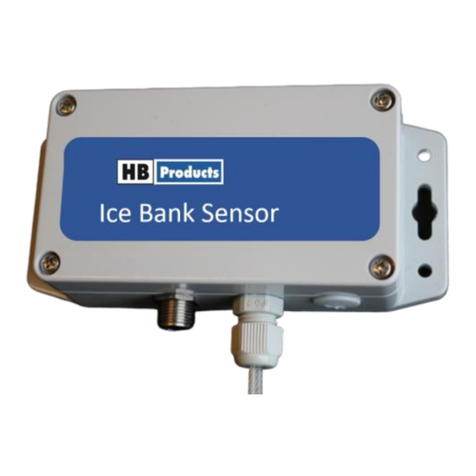
HB Products
HB Products HBIB Use and care manual
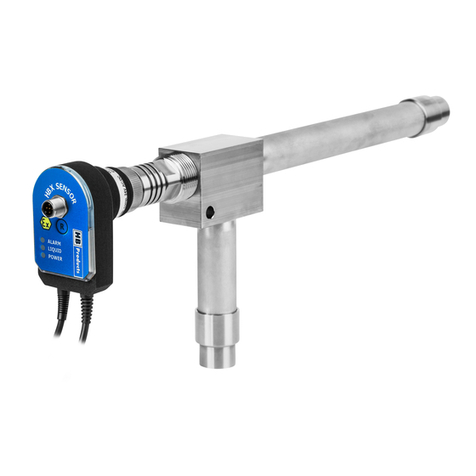
HB Products
HB Products HBX Vapor Quality sensor Operator's manual
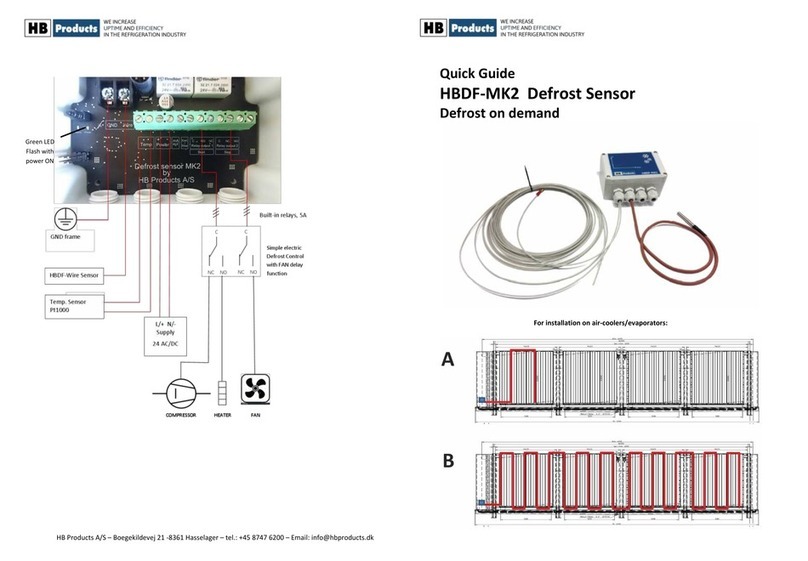
HB Products
HB Products HBDF-MK2 User manual

HB Products
HB Products HBDF User manual

HB Products
HB Products HBCP User manual
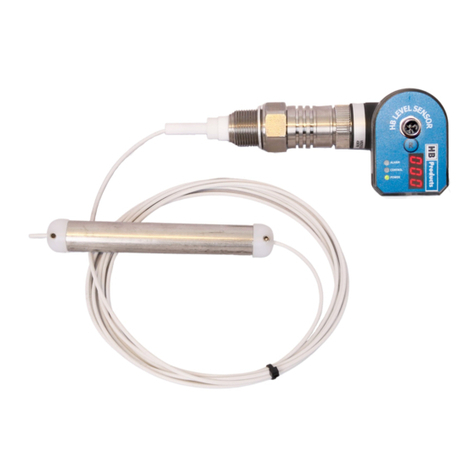
HB Products
HB Products HBLT User manual

HB Products
HB Products HBLC User manual
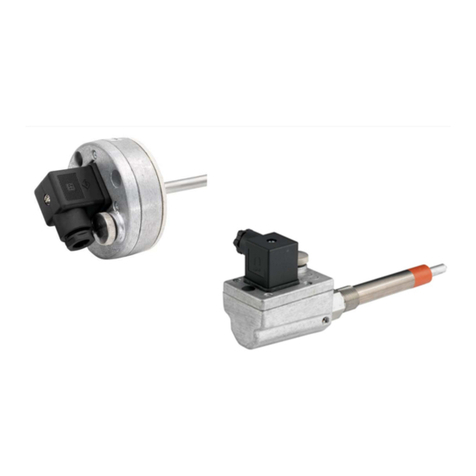
HB Products
HB Products SLCD-M1/_Ex Series User manual
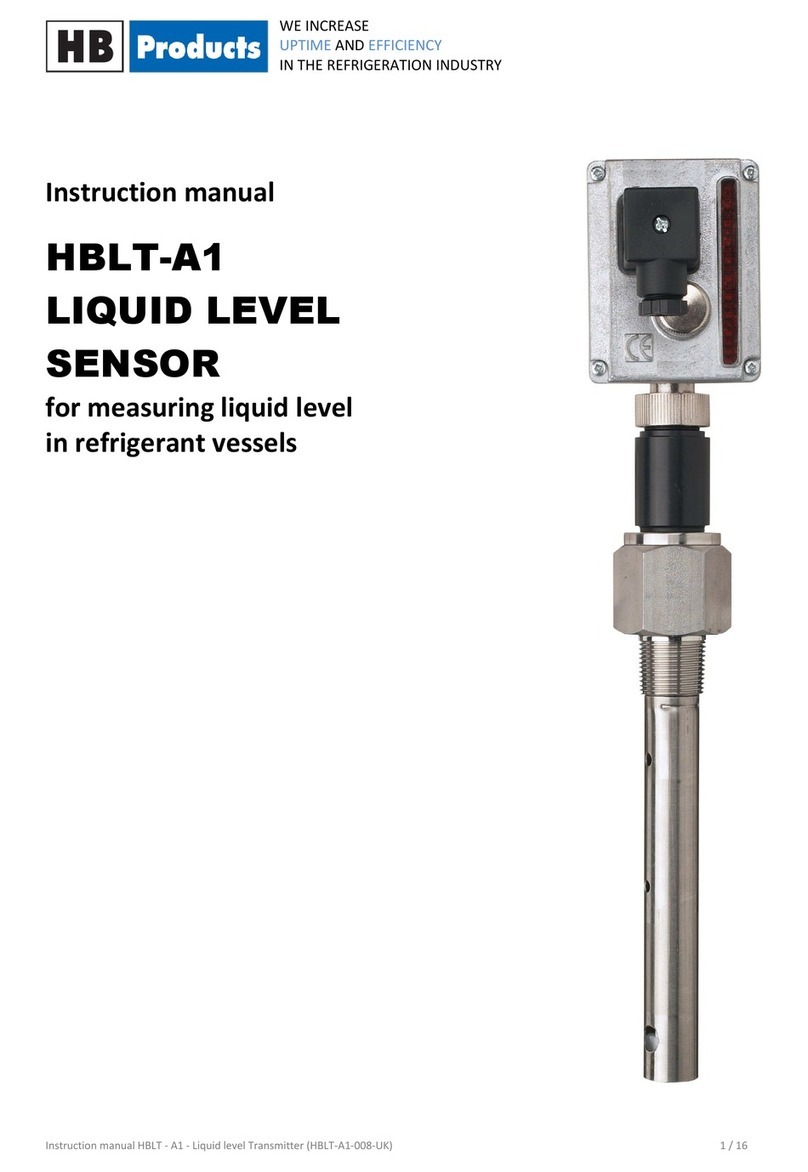
HB Products
HB Products HBLT-A1 User manual

HB Products
HB Products HBDF MK2 User manual
